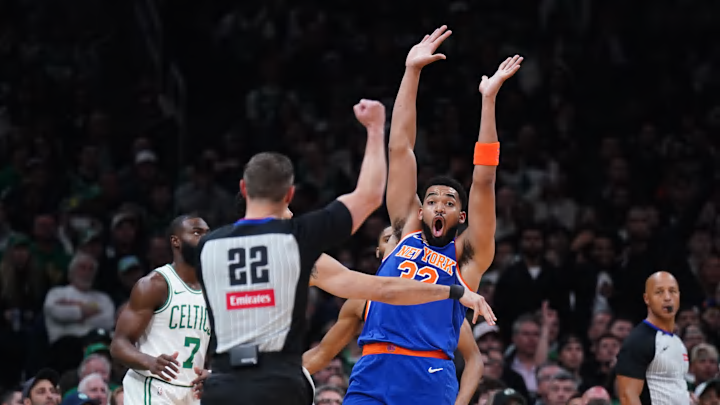In the first half of Game 1, the Knicks were whistled for 13 personal fouls while the Celtics had 14. The 17 fouls were tied for the most in a half in the playoffs this season. It was quite the contrast from the dogfights that the Celtics and Knicks went through in their respective first-round matchups.
The first round series that the Knicks and Celtics went through, against the Pistons and Magic, were bloodbaths. Bodies were on the floor at all times, players were getting mauled when they went to the rim, and the official's whistles remained tucked in their pockets as often as possible. If those series were wars, the start of this series felt like ballet.
So what caused the huge jump in foul calls? Could the refs really be calling the games this differently on a series-to-series basis? The answer is complicated and multi-layered.
Intentional fouls and defensive islands
The first layer is that some of those fouls from the Celtics were intentional. As was the case in the Pistons' series, the Celtics chose to hack-a-Mitch. In other words, intentionally fouling Mitchell Robinson, who is a career 52.2 percent free-throw shooter.
The Celtics used this strategy at least three times in the first half. I say at least three because it isn't crystal clear how much this foul in the clip below by Luke Kornet falls into that category.
— bk (@vidaudio45) May 6, 2025
The next layer is that the Knicks used a new defensive scheme in Game 1, specifically switching all ball screens in an attempt to keep themselves out of rotation and force the Celtics into more isolation.
In the regular season, the Knicks switched less than any team in the league, so the decision was a surprising one. In Game 1, they switched 33 times on pick-and-rolls, easily the most of any game this season.
Knicks pick-and-roll switches in a game this season
— Yaya Dubin (@JADubin5) May 6, 2025
2/8 vs BOS: 18
10/25 vs IND: 18
1/12 vs MIL: 18
12/21 vs NOP: 21
1/15 vs PHI: 22
...
Game 1 vs BOS: 33
In many ways, the strategy yielded very promising results for the Knicks. Against the Celtics, the Knicks conceded 0.76 points per direct pick, significantly lower than other games where they had switched a lot (a lot for them, that is).
Pts/direct pick vs those switches
— Yaya Dubin (@JADubin5) May 6, 2025
2/8 vs BOS: 1.375
10/25 vs IND: 1.333
1/12 vs MIL: 1.750
12/21 vs NOP: 1.118
1/15 vs PHI: 1.333
...
Game 1 vs BOS: 0.762 https://t.co/pWVQ1qVfVz
The negative impact of that is that it left their centers, Karl-Anthony Towns and Robinson, to guard in space. Towns is already prone to falling into foul trouble. In fact, in the regular season, he found himself in foul trouble the second-most often of any player in the NBA. The new defensive scheme only amplified that problem.
Towns picked up two fouls in the first quarter, which forced him to the bench earlier than the Knicks would have liked. He picked up a third foul in the second quarter and a fourth foul in the third quarter.
In the play below, the Celtics use a ball screen from Kristaps Porzingis to get Jayson Tatum onto Towns. Tatum then blows by Towns and gets to the free-throw line.
— bk (@vidaudio45) May 6, 2025
Questionable calls
The other layer is that, yes, the refs were calling a much tighter game. There were several calls with marginal contact that weren't called in the first round. The playoffs have historically seen an uptick in physicality from the regular season, and it should! The stakes are higher, there is more on the line, and it makes the game more interesting.
This year in particular, it felt like that uptick in physicality was cranked even higher than normal. At certain points, it felt like an entirely different sport than what we had watched in the regular season.
The NBA has to find a balance. Increased intensity is good for the game, but wild variance in how the game is called, whether it is game to game or series to series, is not.
